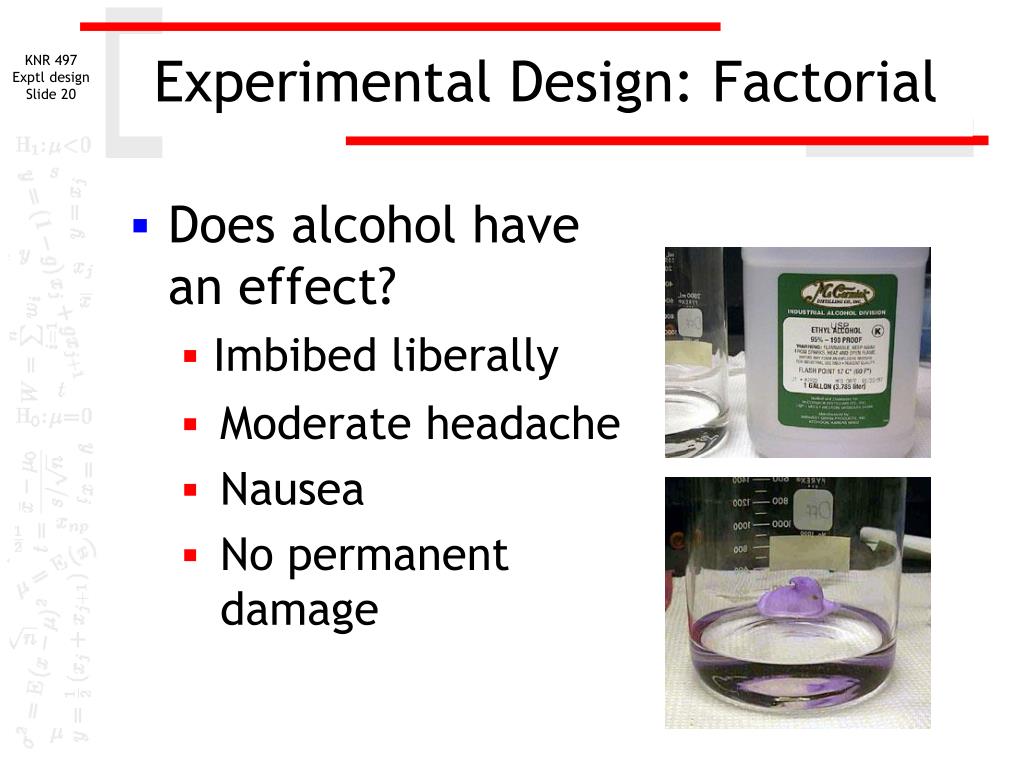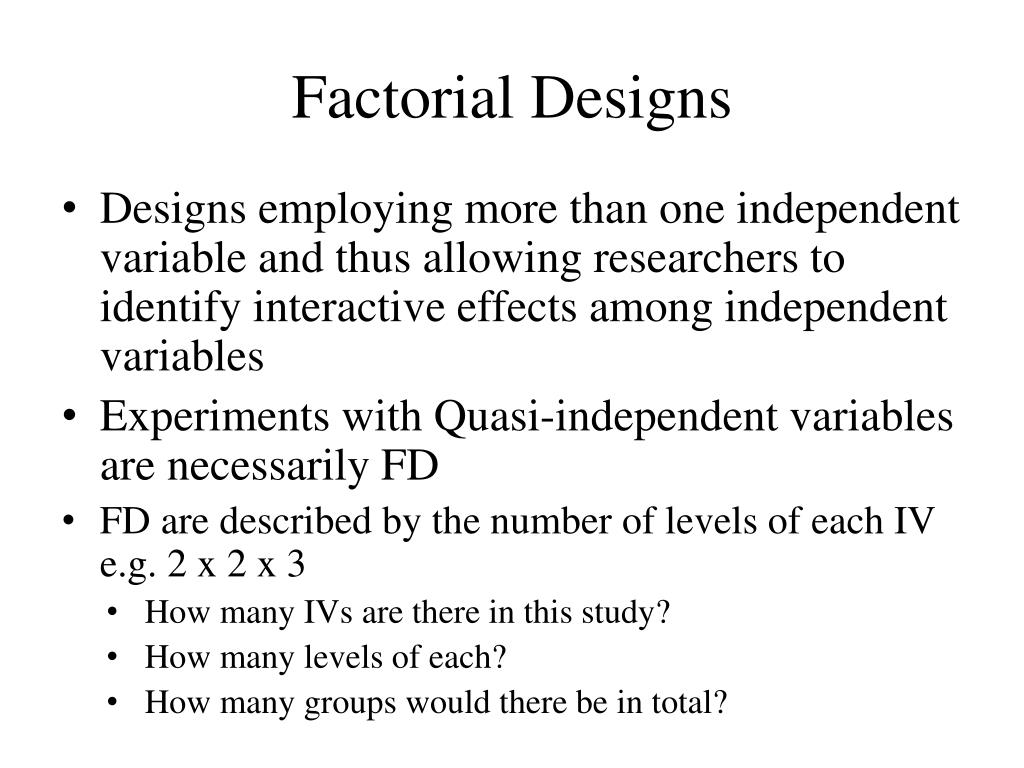Table Of Content

Therefore, the proper name for the factorial design of experiments would be completely randomized factorial design of experiments. This main total effect value for each variable or variable combination will be some value that signifies the relationship between the output and the variable. For instance, if your value is positive, then there is a positive relationship between the variable and the output (i.e. as you increase the variable, the output increases as well). So while the largest main total effect value in one set of experiments may have a value of 128, another experiment may have its largest main total effect value be 43. Frank Yates created an algorithm to easily find the total factorial effects in a 2n factorial that is easily programmable in Excel.
Factorial Design Settings
For example, suppose that you have a reactor and want to study the effect of temperature, concentration and pressure on multiple outputs. In order to minimize the number of experiments that you would have to perform, you can utilize factorial design. This will allow you to determine the effects of temperature and pressure while saving money on performing unnecessary experiments. The following Yates algorithm table was constructed using the data from the interaction effects section.
Design of Experiments with R. Building 2^k Factorial Designs by Roberto Salazar - Towards Data Science
Design of Experiments with R. Building 2^k Factorial Designs by Roberto Salazar.
Posted: Tue, 03 Dec 2019 05:32:29 GMT [source]
Quantitative Research – Methods, Types and...
In the 2 × 3 example, for instance, the pattern of the A column follows the pattern of the levels of factor A, indicated by the first component of each cell. Treatment combinations are denoted by ordered pairs or, more generally, ordered tuples. In the aquaculture experiment, the ordered triple (25, 80, 10) represents the treatment combination having the lowest level of each factor.
Non-Experimental Studies With Factorial Designs
There is an increasing chance of suffering from a seizure at higher doses for 20 year olds, but no difference in suffering from seizures for 40 year olds. Thus, there must be an interaction effect between the dosage of CureAll, and the age of the patient taking the drug. When you have an interaction effect it is impossible to describe your results accurately without mentioning both factors.
The researchers then decided to look at three levels of sleep (4 hours, 6 hours, and 8 hours) and only two levels of caffeine consumption (2 cups versus no coffee). The researchers note that the effects of the memory drug are more pronounced with the simple memory tasks, but not as apparent when it comes to the complex tasks. In this 3×2 factorial design, there is an interaction effect between the drug dosage and the complexity of the memory task. An interaction is a result in which the effects of one experimental manipulation depends upon the experimental manipulation of another independent variable. For example, imagine that a researcher wants to do an experiment looking at whether sleep deprivation hurts reaction times during a driving test.
Additionally, a low and high value are initially listed as -1 and 1, where -1 is the low and 1 is the high value. The low and high levels for each factor can be changed to their actual values in this menu. For a 2 level design, click the "2-level factorial (default generators)" radio button.

However, the number of factors used and the types and number of levels per factor can certainly affect staff burden. A 5-factor design with 2-levels/factor yields some 32 unique combinations of components (Table 1), and requires that at least five different active or “on” ICs be delivered. Moreover, if instead of “off” or no-treatment conditions, less intensive levels of components are used, then even more ICs must be delivered (albeit some of reduced intensity).
A, Prediction variance as a function of the fraction of design space (FDS). B, The variance profile across the range of concentrations for both designs. Similarly, observing participants’ preferences between these foods when served warm versus cold relates to the main effect for temperature. Researchers want to determine how the amount of sleep a person gets the night before an exam impacts performance on a math test the next day. But the experimenters also know that many people like to have a cup of coffee (or two) in the morning to help them get going. For example, imagine that researchers want to test the effects of a memory-enhancing drug.
How design of experiments lowers costs in R&D - Scientific Computing World
How design of experiments lowers costs in R&D.
Posted: Wed, 29 Mar 2023 11:18:22 GMT [source]
Descriptive statistics are used to summarize and describe the data collected in the study. This includes measures such as mean, median, mode, range, and standard deviation. Physiological measures involve measuring participants’ physiological responses, such as heart rate, blood pressure, or brain activity, using specialized equipment.
This table reflects the combinations of intervention components (conditions) that is generated by the crossing of two levels of five factors in a factorial design (Schlam et al. 2016). The table shows that the crossing of the five factors generates 32 unique combinations of intervention components; participants in the experiment were randomly assigned to one of these conditions so that approximately 1/32 of the N was assigned to each condition. One of the big advantages of factorial designs is that they allow researchers to look for interactions between independent variables. In this type of study, there are two factors (or independent variables), each with two levels. Full factorial designs grow large as the number of factors increases, but we can use fractional factorial designs to reduce the number of runs required by considering only a fraction of the full factorial runs (e.g., half as many in a 26–1 design).
Rather, there is an interaction effect between the two independent variables. If concentration were a categorical factor, we could compare the mean response at nine concentrations—a traditional randomized complete block design (RCBD)1. However, because concentration is actually continuous, discrete levels unduly limit which concentrations are studied and reduce our ability to detect an effect and estimate the concentration that produces an optimal response. Classical designs, like full factorials or RCBDs, assume an ideal and simple experimental setup, which may be inappropriate for all experimental goals or untenable in the presence of constraints. The investigator plans to manipulate each of these components experimentally.

No comments:
Post a Comment